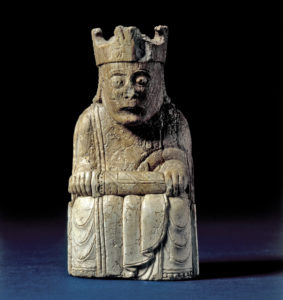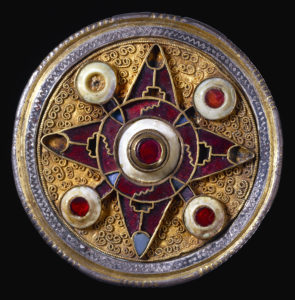From the fall of the Roman Empire in about 400 AD to the start of the Renaissance in about 1500, lies a span of years that looks like a dark age … a time when lives were seemingly nasty, brutish and short.
There certainly was a lot of that in the Middle Ages (remember the Black Death?), but it was also a time in which many of the institutions with us today were begun from universities to churches, cities, fashion and the nation state.
That really is the point of the eye-opening exhibition Medieval Europe – Power and Splendour which opens to the public on Friday.
More than 200 artifacts show the depth of the creative and political culture that emerged in Europe after the fall of Rome to the invading tribes that left Asia and crossed into Europe in the time. There are pieces of armour, tapestries, small exquisite pieces of jewelry, sculptures and other items that hint at the diversity of the cultural output of Europeans of the time.

Figurine of a Knight 1375–1425 AD, England. © The Trustees of the British Museum. Perhaps representing St. George, this figurine epitomizes the medieval knight. His body is protected with a suit of plate armour, with chain- mail covering the exposed areas of his neck and lower body. Clearly well-armed, he has a sword and shield, and is possibly holding a lance. The richest soldiers were the best armed and protected.
It was a time of great kings such as Charlemagne and Richard II of England. Churches such as Notre Dame and Westminster Abbey were built in this time.
The exhibition was assembled by the British Museum in London and the pieces of the past come from other institutions as well, including the Victoria and Albert Museum in London, Eng., the Royal Armouries in London, the National Gallery of Canada, McGill University and the Canadian Museum of History. This will be the only appearance in North America of this show which has also been seen in Queensland, Australia and in three locations in Spain. About 350,000 people have viewed it so far. The British Museum is actively sharing the artifacts of its collection around the world as part of its mandate of being a museum of the world for the world. The two museums have been planning this particular show for about the past four years.
‘The Middle Ages have been viewed as a period that was backward and stagnant (in the wake of the fall of the Roman Empire),” said Jean-Marc Blais, director general of the Canadian Museum of History, before a media preview of the show on Wednesday. “It was actually a vibrant place, a civilization on the move.”

King from the Lewis Chessmen 1150–1200 AD, possibly Norway, found in Scotland. © The Trustees of the British Museum. Found as part of a hoard on the Isle of Lewis, Scotland, this chess king represents the ideal medieval leader. He is a symbol of masculine strength, with a thick beard and moustache. The sword, placed over the king’s lap and gripped by both hands, suggests a ruler who is ready to draw his blade and fight. The throne, crown and decorated clothes all indicate his wealth and status.
In fact, what we call the Middle Ages is not one seamless span of time, says co-curators Michael Lewis of the British Museum.
“It’s a massive period of time. It starts from the end of the fall of the Roman period to the Renaissance. There are two main phases within that. There is the time from 400 AD, to the 11 century where we do have these ‘tribes’ taking over in the vacuum left by Rome, establishing small kingdoms. This migration period and the development of nation-states is very different from the high medieval period which is what the bulk of the exhibition is about.”
The show also looks at the aspects of the time that are drawing Europe together.
“The basic story is how Europe becomes quite culturally similar in the High Middle Ages. European monarchs (of the time) identified with each other and they wanted to emulate each other,” Lewis said. This means that artifacts from different countries have a similar look to them.
“For example, you get objects made in France that are used all over Western Europe. The exhibition highlights the wonderful diversity of objects, but also the commonality in culture that starts in the medieval period.”

The Wingham Brooch. 575–625 AD, England. © The Trustees of the British Museum. All rights reserved. This brooch is of a type popular during the 500s and early 600s in Kent, an Anglo-Saxon kingdom in Southeast England. Kent forged healthy trade and diplomatic contacts with Frankia (centring on modern-day France and parts of Germany). This brooch is a testament to the kingdom’s increasing wealth and status.
The legacy section of the show picks up themes of what we know about how the Middle Ages influence society today such as the ideas of scholarship in the universities founded in this period such as Oxford and liberties and human rights in documents such as Magna Carta.
“There are lots of things that we can look back to the medieval period and say this is where it sort of started. From a cultural perspective I think there is a European identity and people in North American share some elements of that,” Lewis said.
That is the significance of the last section of the exhibition, which was developed by the Museum of History, takes a look at the medieval legacy in Canada. Manuscripts, works of art and artifacts provide insight into laws, literature and more.
“What is interesting about the Middle Ages is that you can have a lot of political change but stability can be found in terms of people’s cultural sensibility.”
Lewis likes many of the artifacts, “but there are certain ones that I particularly like. In the first section there is the Wingham Brooch. It is a very small Anglo-Saxon brooch. I suppose I like it because of the way that it is crafted. It is from what we used to call the Dark Ages. The skill and tools they would have available it would have been almost impossible to replicate today. How could they have done that?
The brooch, which was found in a grave, has garnets and behind them gold leaf. “It’s a lot more than just a brooch,” Lewis said. It’s imbued with a sophisticated artistic sensibility and carries with it social significance, he added. Dark Ages indeed.
Throughout the run of the show there will be family activities, a gourmet wine tasting and an in‑gallery opportunity to try on reproductions of medieval armour, while learning about the life of a knight.
Medieval Europe – Power and Splendour runs until Jan. 20.






